ECU Lexus IS220d 2012 Service Manual
[x] Cancel search | Manufacturer: LEXUS, Model Year: 2012, Model line: IS220d, Model: Lexus IS220d 2012Pages: 609, PDF Size: 14.63 MB
Page 470 of 609
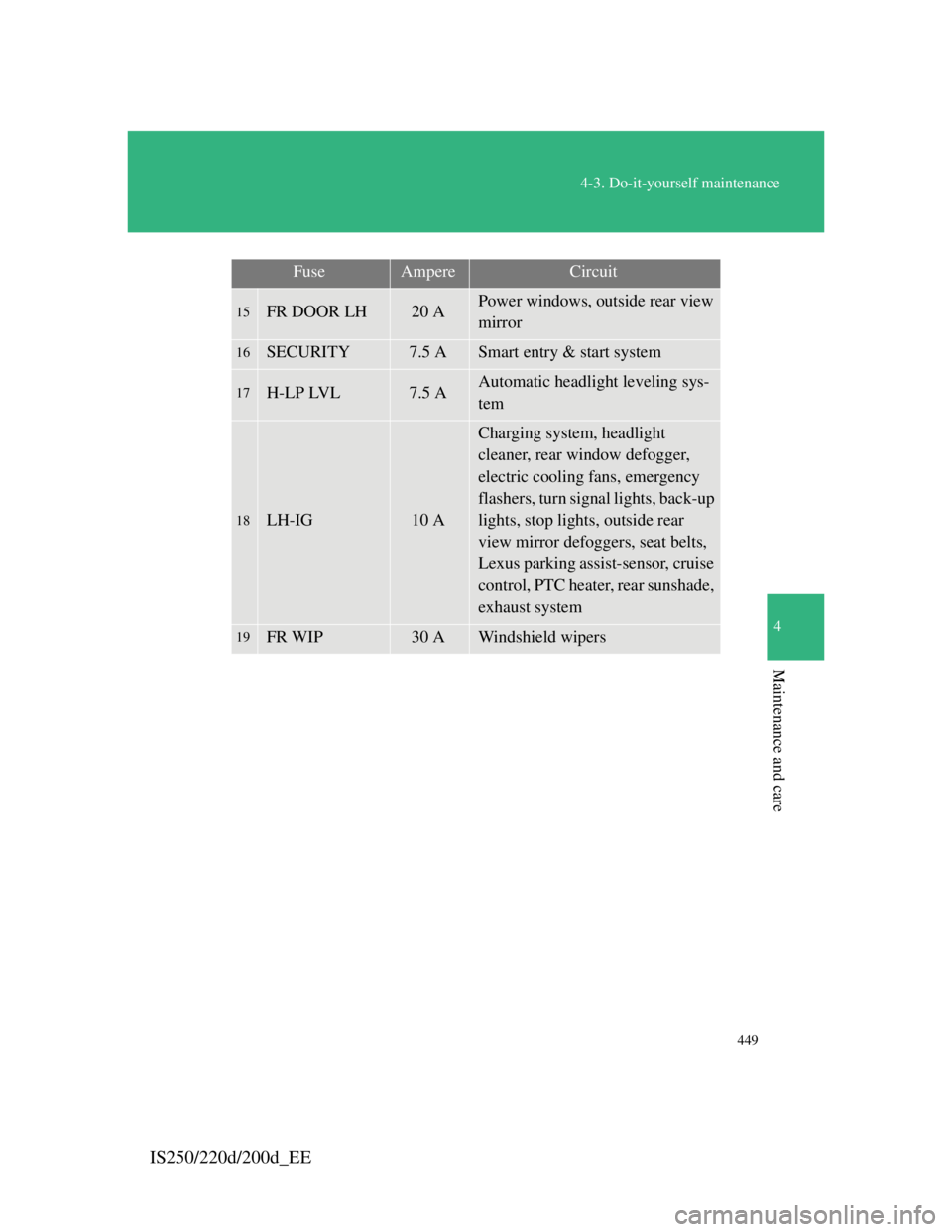
449
4-3. Do-it-yourself maintenance
4
Maintenance and care
IS250/220d/200d_EE
15FR DOOR LH20 APower windows, outside rear view
mirror
16SECURITY7.5 ASmart entry & start system
17H-LP LVL7.5 AAutomatic headlight leveling sys-
tem
18LH-IG10 A
Charging system, headlight
cleaner, rear window defogger,
electric cooling fans, emergency
flashers, turn signal lights, back-up
lights, stop lights, outside rear
view mirror defoggers, seat belts,
Lexus parking assist-sensor, cruise
control, PTC heater, rear sunshade,
exhaust system
19FR WIP30 AWindshield wipers
FuseAmpereCircuit
Page 472 of 609
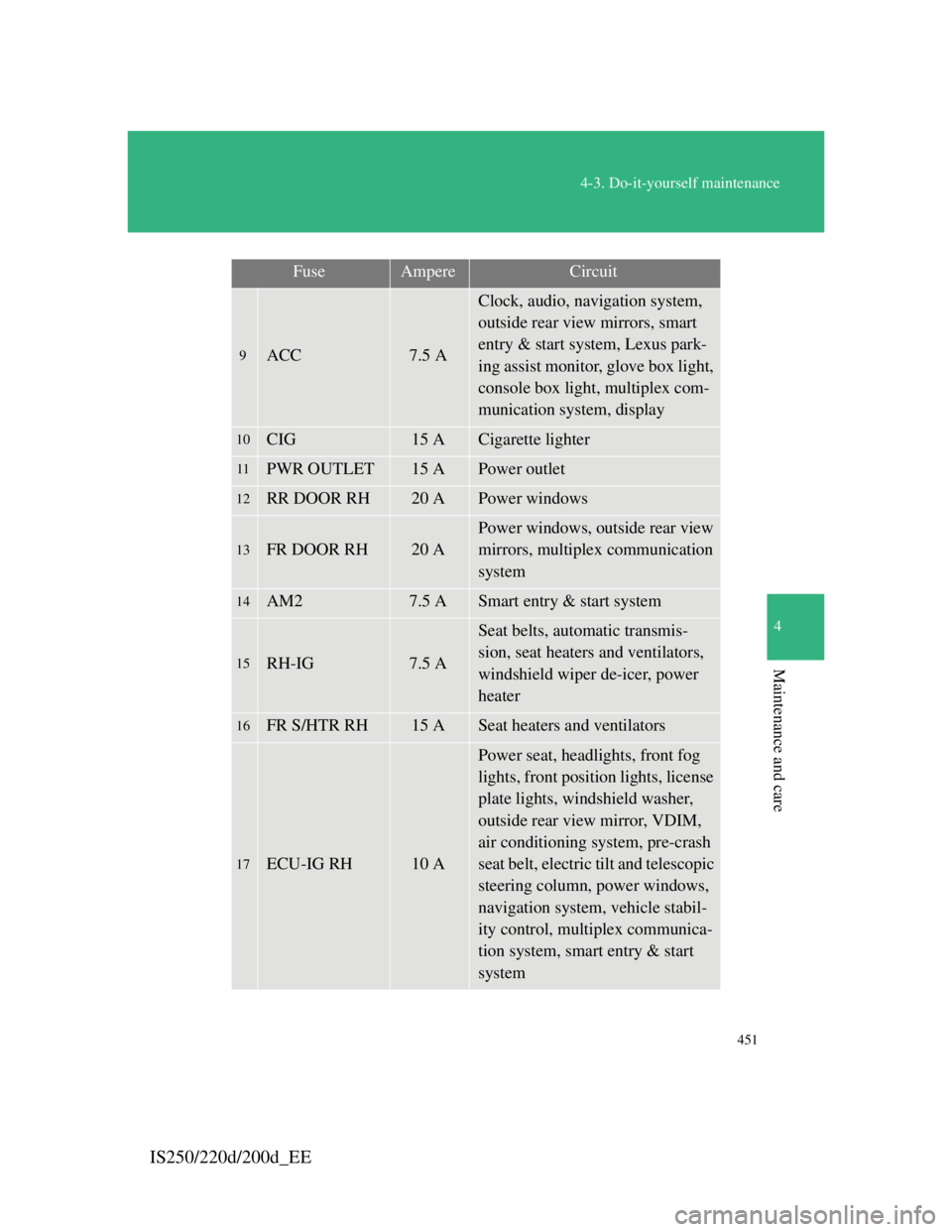
451
4-3. Do-it-yourself maintenance
4
Maintenance and care
IS250/220d/200d_EE
9ACC7.5 A
Clock, audio, navigation system,
outside rear view mirrors, smart
entry & start system, Lexus park-
ing assist monitor, glove box light,
console box light, multiplex com-
munication system, display
10CIG15 ACigarette lighter
11PWR OUTLET15 APower outlet
12RR DOOR RH20 APower windows
13FR DOOR RH20 A
Power windows, outside rear view
mirrors, multiplex communication
system
14AM27.5 ASmart entry & start system
15RH-IG7.5 A
Seat belts, automatic transmis-
sion, seat heaters and ventilators,
windshield wiper de-icer, power
heater
16FR S/HTR RH15 ASeat heaters and ventilators
17ECU-IG RH10 A
Power seat, headlights, front fog
lights, front position lights, license
plate lights, windshield washer,
outside rear view mirror, VDIM,
air conditioning system, pre-crash
seat belt, electric tilt and telescopic
steering column, power windows,
navigation system, vehicle stabil-
ity control, multiplex communica-
tion system, smart entry & start
system
FuseAmpereCircuit
Page 481 of 609
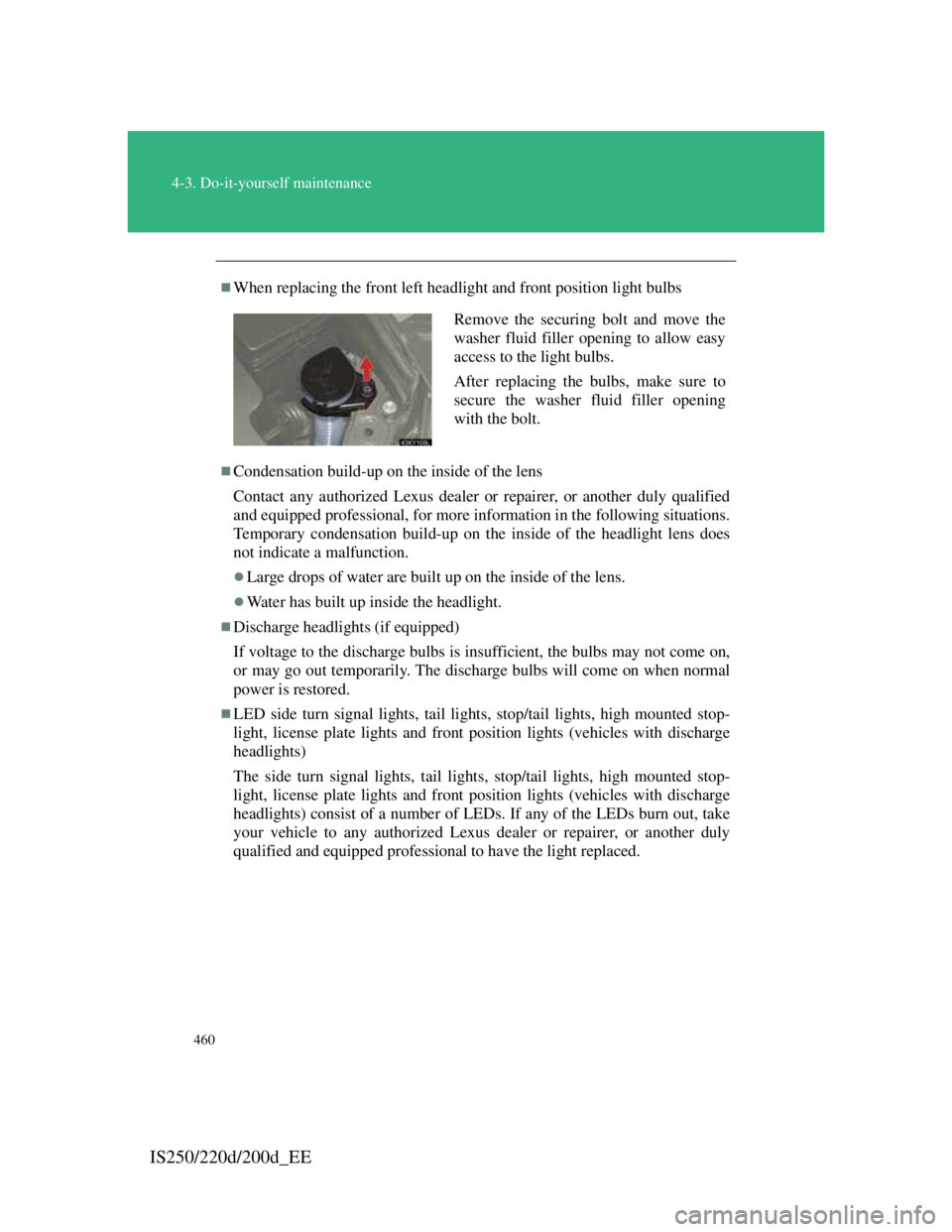
460
4-3. Do-it-yourself maintenance
IS250/220d/200d_EE
When replacing the front left headlight and front position light bulbs
Condensation build-up on the inside of the lens
Contact any authorized Lexus dealer or repairer, or another duly qualified
and equipped professional, for more information in the following situations.
Temporary condensation build-up on the inside of the headlight lens does
not indicate a malfunction.
Large drops of water are built up on the inside of the lens.
Water has built up inside the headlight.
Discharge headlights (if equipped)
If voltage to the discharge bulbs is insufficient, the bulbs may not come on,
or may go out temporarily. The discharge bulbs will come on when normal
power is restored.
LED side turn signal lights, tail lights, stop/tail lights, high mounted stop-
light, license plate lights and front position lights (vehicles with discharge
headlights)
The side turn signal lights, tail lights, stop/tail lights, high mounted stop-
light, license plate lights and front position lights (vehicles with discharge
headlights) consist of a number of LEDs. If any of the LEDs burn out, take
your vehicle to any authorized Lexus dealer or repairer, or another duly
qualified and equipped professional to have the light replaced.
Remove the securing bolt and move the
washer fluid filler opening to allow easy
access to the light bulbs.
After replacing the bulbs, make sure to
secure the washer fluid filler opening
with the bolt.
Page 482 of 609
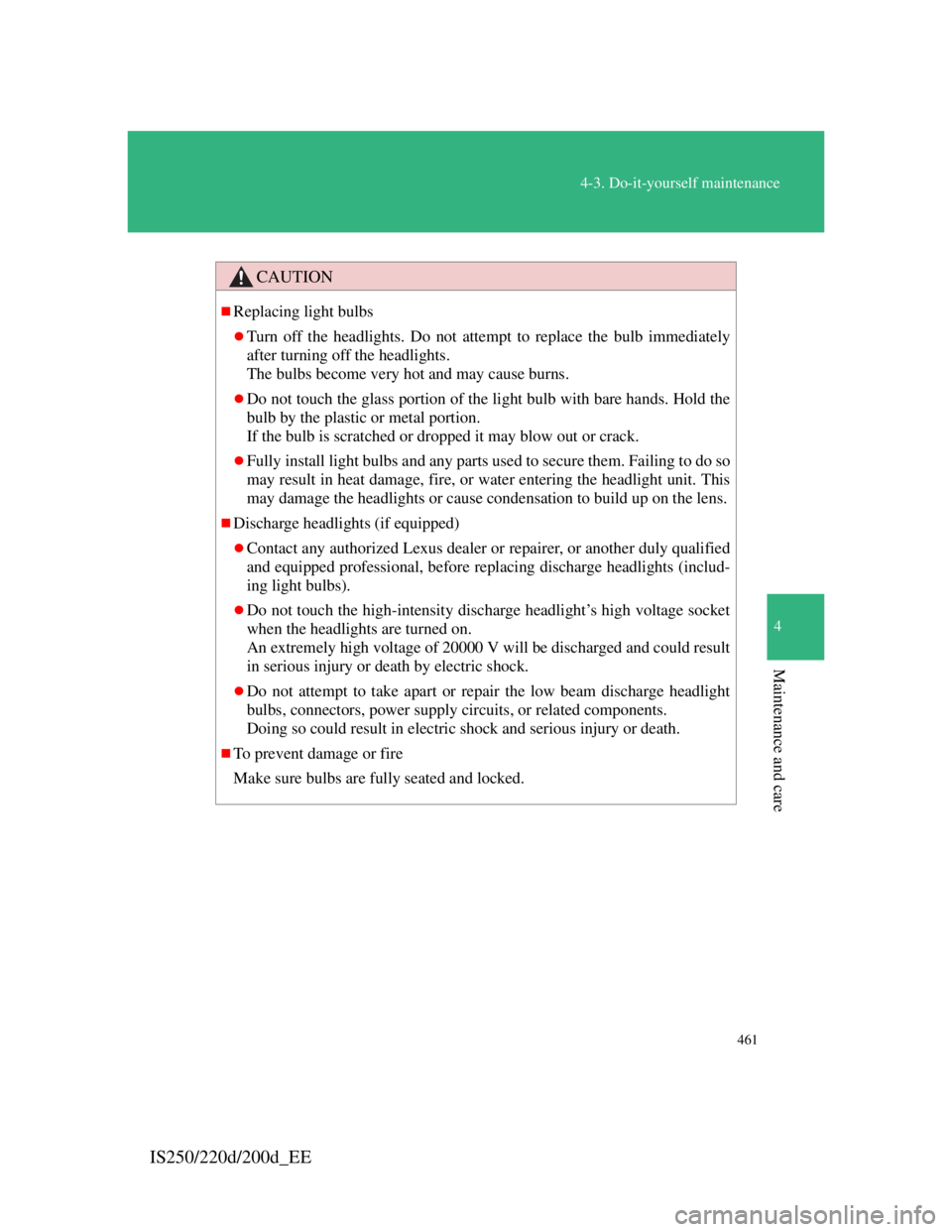
461
4-3. Do-it-yourself maintenance
4
Maintenance and care
IS250/220d/200d_EE
CAUTION
Replacing light bulbs
Turn off the headlights. Do not attempt to replace the bulb immediately
after turning off the headlights.
The bulbs become very hot and may cause burns.
Do not touch the glass portion of the light bulb with bare hands. Hold the
bulb by the plastic or metal portion.
If the bulb is scratched or dropped it may blow out or crack.
Fully install light bulbs and any parts used to secure them. Failing to do so
may result in heat damage, fire, or water entering the headlight unit. This
may damage the headlights or cause condensation to build up on the lens.
Discharge headlights (if equipped)
Contact any authorized Lexus dealer or repairer, or another duly qualified
and equipped professional, before replacing discharge headlights (includ-
ing light bulbs).
Do not touch the high-intensity discharge headlight’s high voltage socket
when the headlights are turned on.
An extremely high voltage of 20000 V will be discharged and could result
in serious injury or death by electric shock.
Do not attempt to take apart or repair the low beam discharge headlight
bulbs, connectors, power supply circuits, or related components.
Doing so could result in electric shock and serious injury or death.
To prevent damage or fire
Make sure bulbs are fully seated and locked.
Page 485 of 609
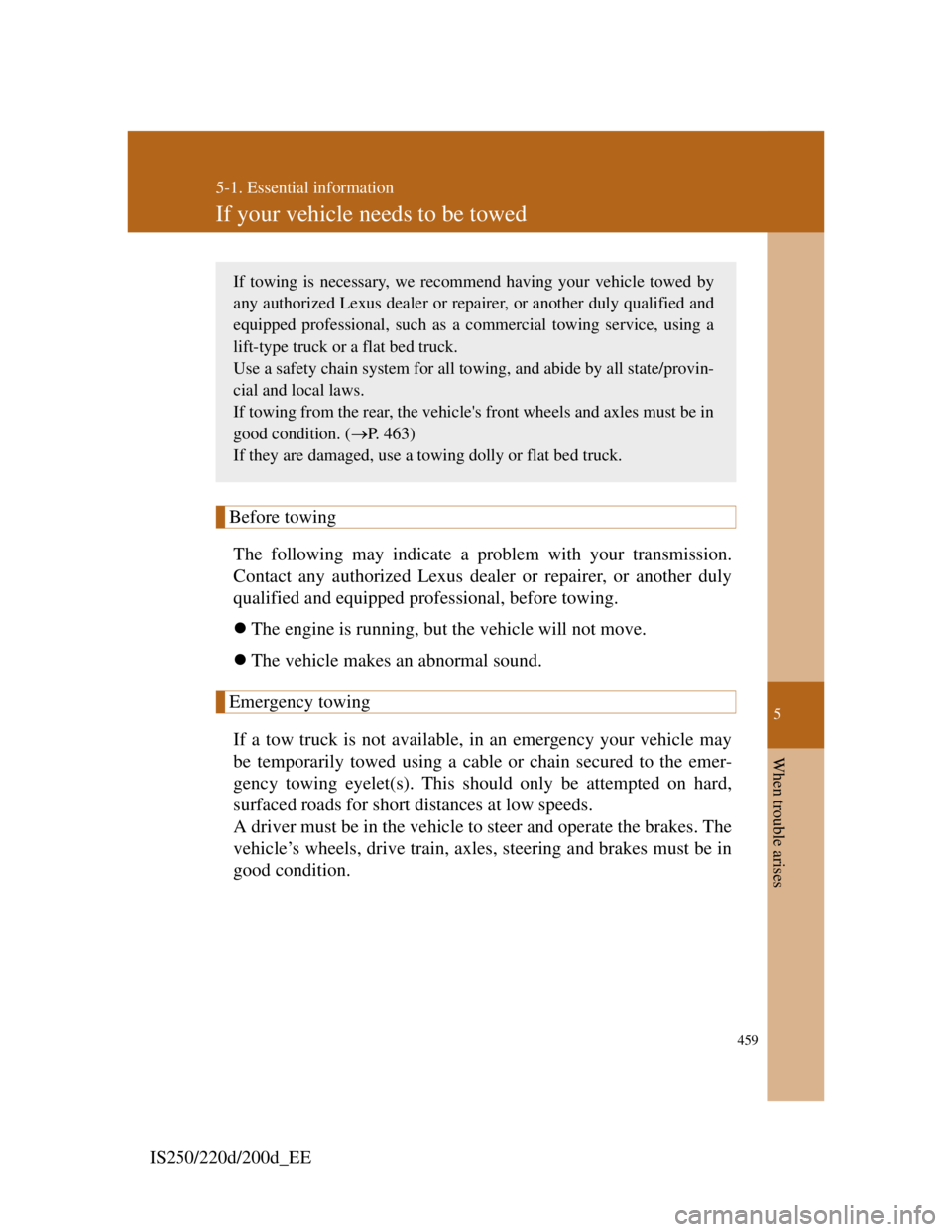
5
459
5-1. Essential information
When trouble arises
IS250/220d/200d_EE
If your vehicle needs to be towed
Before towing
The following may indicate a problem with your transmission.
Contact any authorized Lexus dealer or repairer, or another duly
qualified and equipped professional, before towing.
The engine is running, but the vehicle will not move.
The vehicle makes an abnormal sound.
Emergency towing
If a tow truck is not available, in an emergency your vehicle may
be temporarily towed using a cable or chain secured to the emer-
gency towing eyelet(s). This should only be attempted on hard,
surfaced roads for short distances at low speeds.
A driver must be in the vehicle to steer and operate the brakes. The
vehicle’s wheels, drive train, axles, steering and brakes must be in
good condition.
If towing is necessary, we recommend having your vehicle towed by
any authorized Lexus dealer or repairer, or another duly qualified and
equipped professional, such as a commercial towing service, using a
lift-type truck or a flat bed truck.
Use a safety chain system for all towing, and abide by all state/provin-
cial and local laws.
If towing from the rear, the vehicle's front wheels and axles must be in
good condition. (P. 463)
If they are damaged, use a towing dolly or flat bed truck.
Page 487 of 609
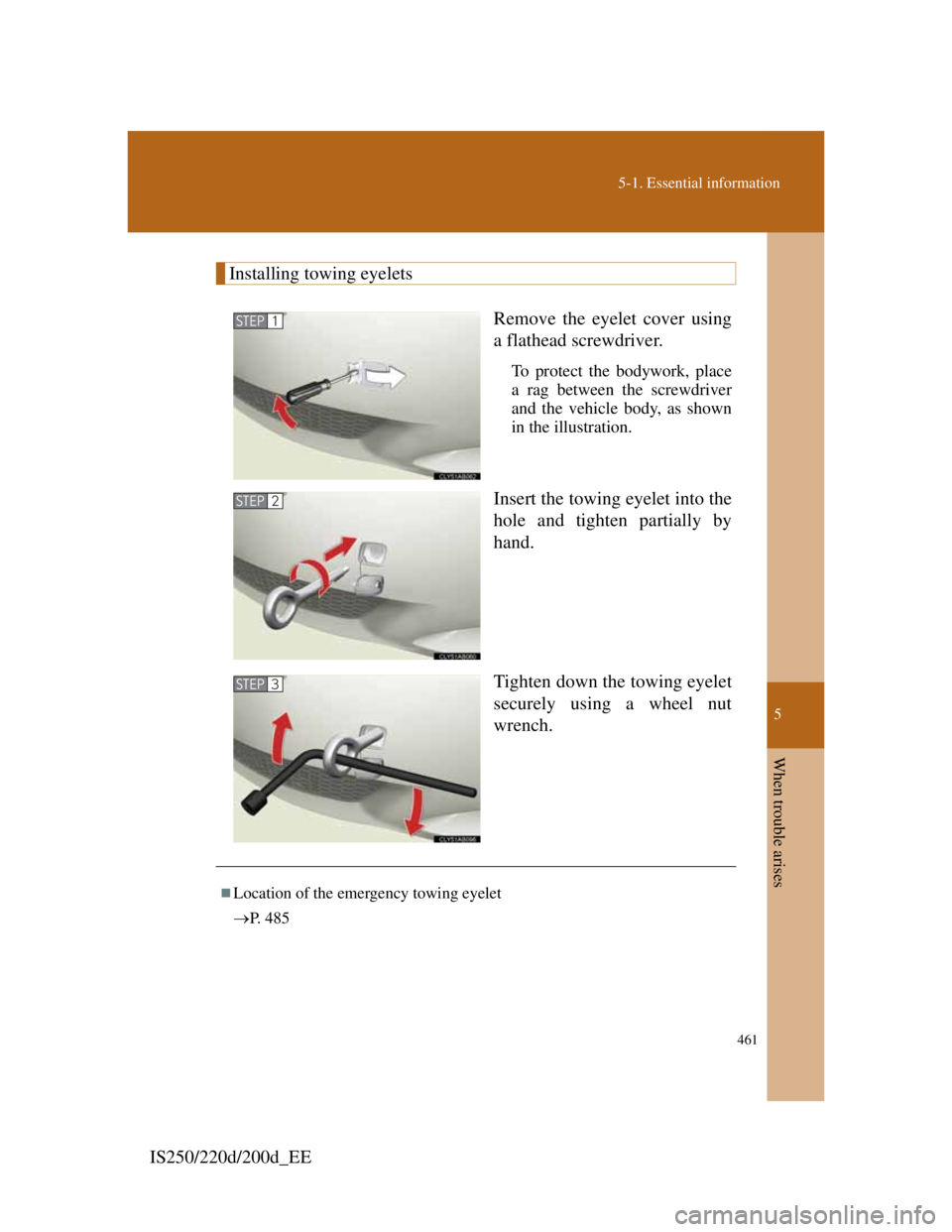
5
461
5-1. Essential information
When trouble arises
IS250/220d/200d_EE
Installing towing eyelets
Remove the eyelet cover using
a flathead screwdriver.
To protect the bodywork, place
a rag between the screwdriver
and the vehicle body, as shown
in the illustration.
Insert the towing eyelet into the
hole and tighten partially by
hand.
Tighten down the towing eyelet
securely using a wheel nut
wrench.
STEP1
STEP2
STEP3
Location of the emergency towing eyelet
P. 4 8 5
Page 488 of 609

462
5-1. Essential information
IS250/220d/200d_EE
Towing with a sling-type truck
CAUTION
Installing towing eyelets to the vehicle
Make sure that towing eyelets are installed securely.
If not securely installed, towing eyelets may come loose during towing. This
may lead to accidents that cause serious injury or even death.
NOTICE
To prevent body damage
Do not tow with a sling-type truck, either from the front or rear.
Page 514 of 609
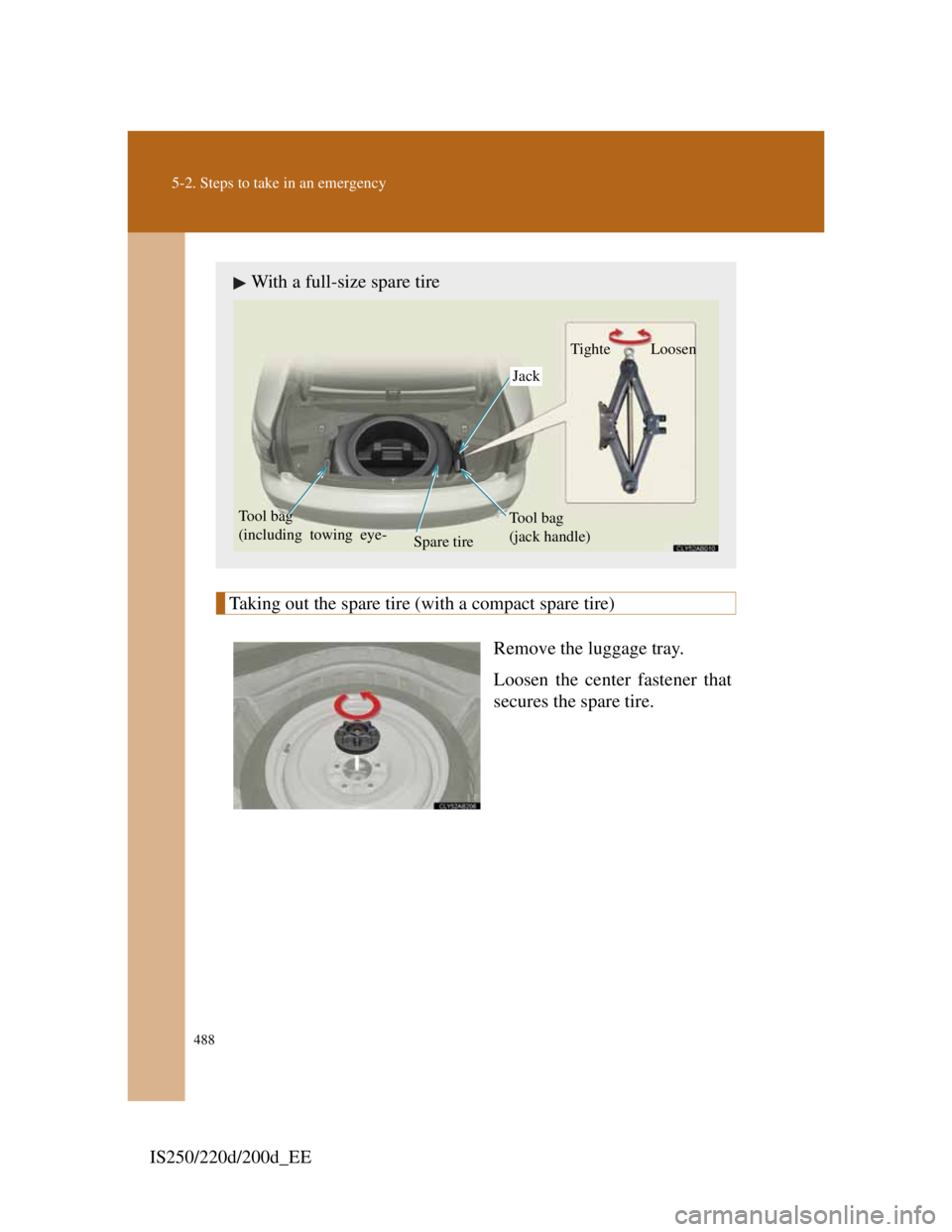
488
5-2. Steps to take in an emergency
IS250/220d/200d_EE
Taking out the spare tire (with a compact spare tire)
Remove the luggage tray.
Loosen the center fastener that
secures the spare tire.
With a full-size spare tire
Tool bag
(including towing eye-
Spare tireTool bag
(jack handle)JackTighte Loosen
Page 515 of 609
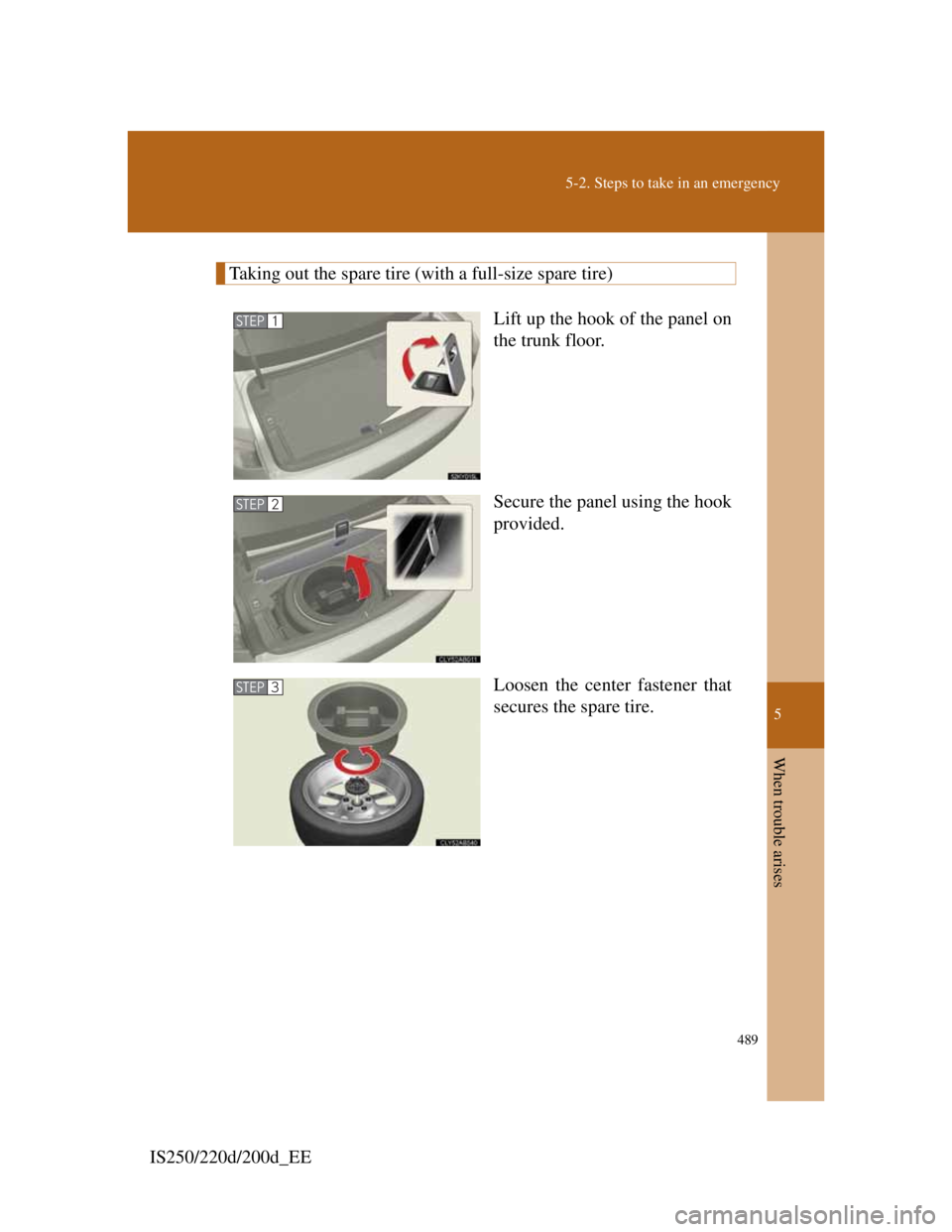
5
489
5-2. Steps to take in an emergency
When trouble arises
IS250/220d/200d_EE
Taking out the spare tire (with a full-size spare tire)
Lift up the hook of the panel on
the trunk floor.
Secure the panel using the hook
provided.
Loosen the center fastener that
secures the spare tire.
STEP1
STEP2
STEP3
Page 522 of 609
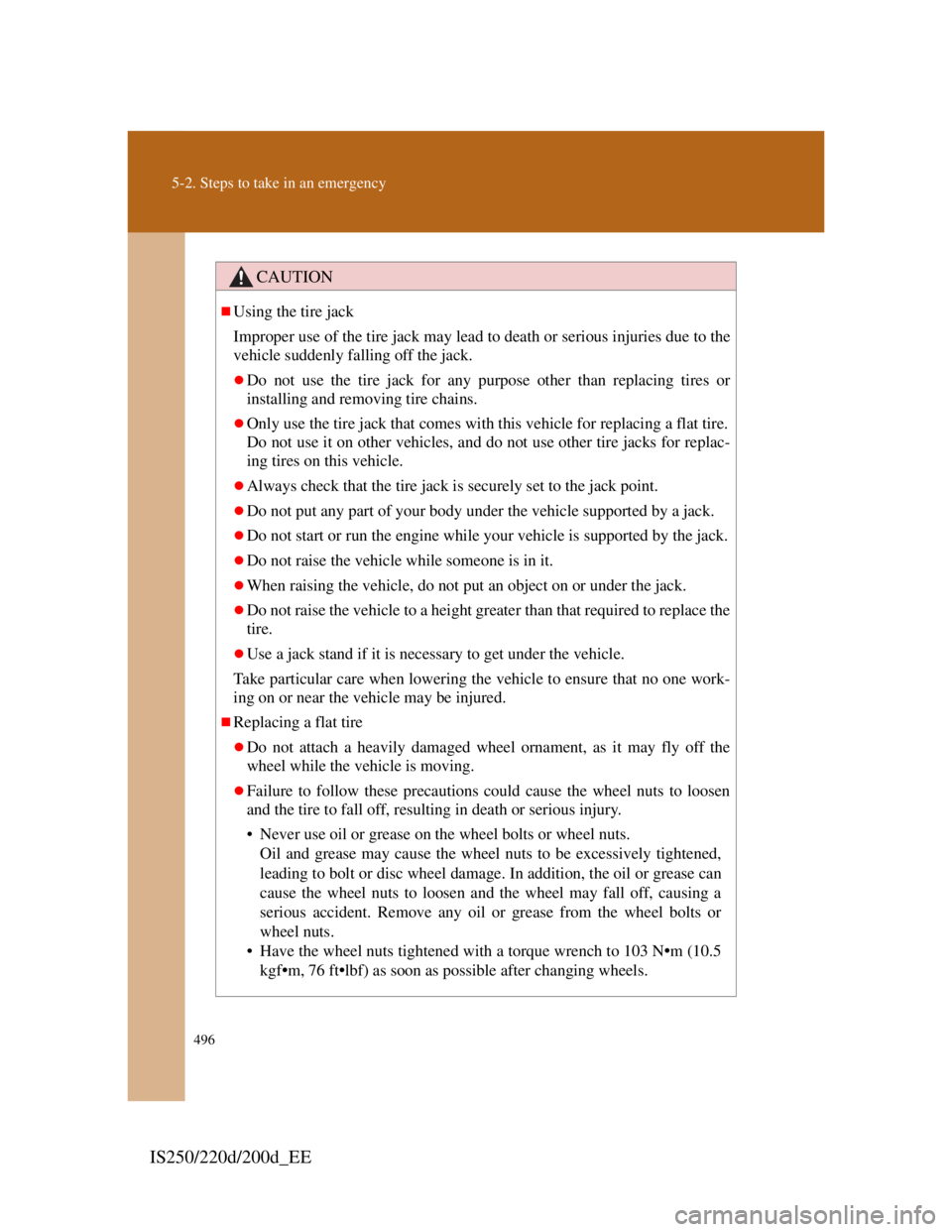
496
5-2. Steps to take in an emergency
IS250/220d/200d_EE
CAUTION
Using the tire jack
Improper use of the tire jack may lead to death or serious injuries due to the
vehicle suddenly falling off the jack.
Do not use the tire jack for any purpose other than replacing tires or
installing and removing tire chains.
Only use the tire jack that comes with this vehicle for replacing a flat tire.
Do not use it on other vehicles, and do not use other tire jacks for replac-
ing tires on this vehicle.
Always check that the tire jack is securely set to the jack point.
Do not put any part of your body under the vehicle supported by a jack.
Do not start or run the engine while your vehicle is supported by the jack.
Do not raise the vehicle while someone is in it.
When raising the vehicle, do not put an object on or under the jack.
Do not raise the vehicle to a height greater than that required to replace the
tire.
Use a jack stand if it is necessary to get under the vehicle.
Take particular care when lowering the vehicle to ensure that no one work-
ing on or near the vehicle may be injured.
Replacing a flat tire
Do not attach a heavily damaged wheel ornament, as it may fly off the
wheel while the vehicle is moving.
Failure to follow these precautions could cause the wheel nuts to loosen
and the tire to fall off, resulting in death or serious injury.
• Never use oil or grease on the wheel bolts or wheel nuts.
Oil and grease may cause the wheel nuts to be excessively tightened,
leading to bolt or disc wheel damage. In addition, the oil or grease can
cause the wheel nuts to loosen and the wheel may fall off, causing a
serious accident. Remove any oil or grease from the wheel bolts or
wheel nuts.
• Have the wheel nuts tightened with a torque wrench to 103 N
•m (10.5
kgf
•m, 76 ft•lbf) as soon as possible after changing wheels.